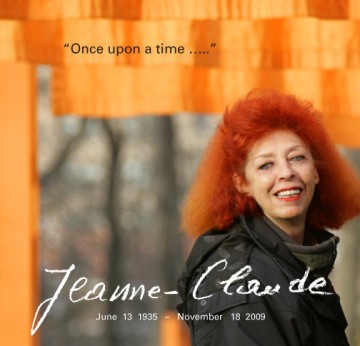
Originally published in the Northside San Francisco in January 2010
Artists don’t retire, they die. That’s all. —Jeanne-Claude
Jeanne-Claude, best known as the co-creator of the 2005 Central Park Installation “The Gates”, died in November after complications from a brain aneurysm. During the last fifty years, Jeanne-Claude and her husband/collaborator Christo helped to create distinctive temporary art installations all over the globe.
Christo and Jeanne-Claude were both born on June 13, 1935. They met in Paris, France in November 1958 and worked together ever since. Jeanne-Claude was from a prominent French family, and Christo was a Bulgarian refugee and a bohemian artist. They met when Christo was commissioned to paint a portrait of Jeanne-Claude’s mother. Their match was not regarded as socially acceptable, but love took their lives on another path. The married and their creative collaboration began. As artists, the use of fabric in large public installations became their trademark epitomized in works like “Running Fence”.
Over a two-week period in February 2005, “The Gates” adorned 23 miles of Central Park with thousands of saffron panels draped inside a total of 7,503 gates spanning over 23 miles of the parks’ walkways. “Running Fence”, a project completed in 1976 in Northern California, consisted of steel bolts and cables connected by an eighteen foot white fabric fence running nearly 25 miles over the hills of Sonoma and Marin counties, with the end of the fence plunging directly into the Pacific Ocean. These ambitious projects stood in completion for only a few days and cost millions of dollars, financed exclusively by the artists themselves. They secured the funds through the sale of the preliminary pictorial studies, collages and scale models of their designs to museums and collectors. State and local organizations as well as private landowners also had to be courted and convinced to provide Christo and Jeanne-Claude with permission to use the land.
Letters were written, phone calls were made and many debates took place before Christo and Jeanne-Claude were allowed to wrap the Reichstag in Berlin. The final spectacle in August 1995 drew tourists from around the world to see the iconic building draped in polypropylene fabric. Similarly, it took nine years of negotiations with the French government to wrap the Pont-Neuf Bridge in Paris in 1985. During the two weeks that the bridge was covered in fabric, nearly three million people visited the completed work.
The prolonged process leading up to the final installation of their work exists as part of the art, according to Christo and Jeanne-Claude. Building permits, permissions, meetings with engineers, government officials and related contractual obstacles were a kind of performance art, a performance that included public debates which questioned “is it art?” The artists often met with resistance from groups who did not want to see their environment changed in any way. Out of necessity, their art also became an education. Christo and Jeanne-Claude had to coax understanding from minds not accustomed to their world of conceptual art, understanding that ultimately provided the public with new ways of seeing the commonplace. Unlike some modern art which can leave the viewers scratching their heads, Christo and Jeanne-Claude’s work has that gentle inclusivity, an immediate aesthetic of simple beauty and joy. Their art succeeds because of their unique ability to communicate.
Though Jeanne-Claude is gone, her collaborative efforts continue. A message posted on their website maps out plans to finish their current projects.
“The art of Christo and Jeanne-Claude will continue. Christo is dedicated to completing their current works in progress: ‘Over the River, Project for the Arkansas River,’ ‘State of Colorado,’ and ‘The Mastaba, Project for the United Arab Emirates,’ as Jeanne-Claude would have wished.”